
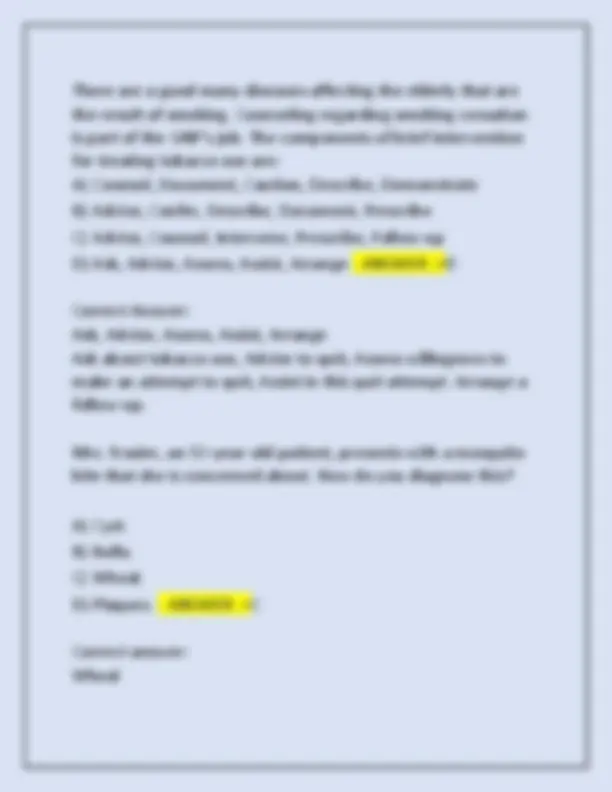
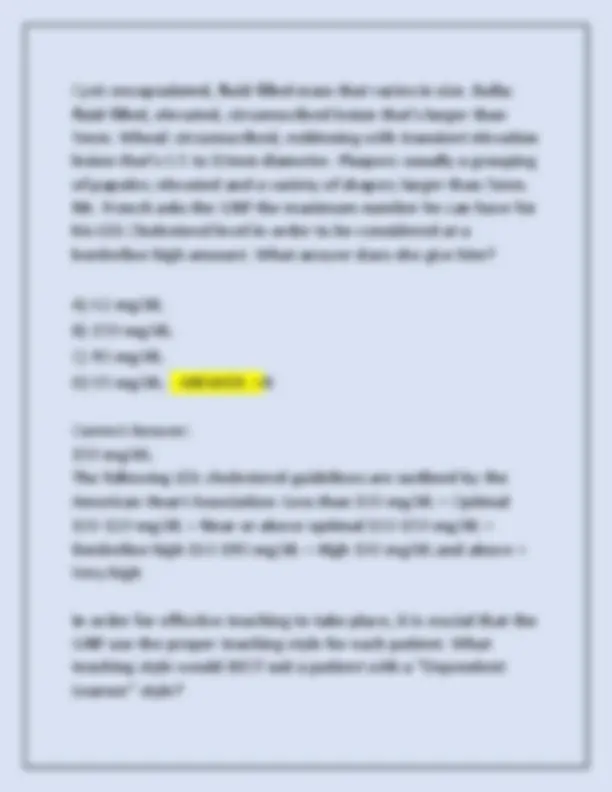
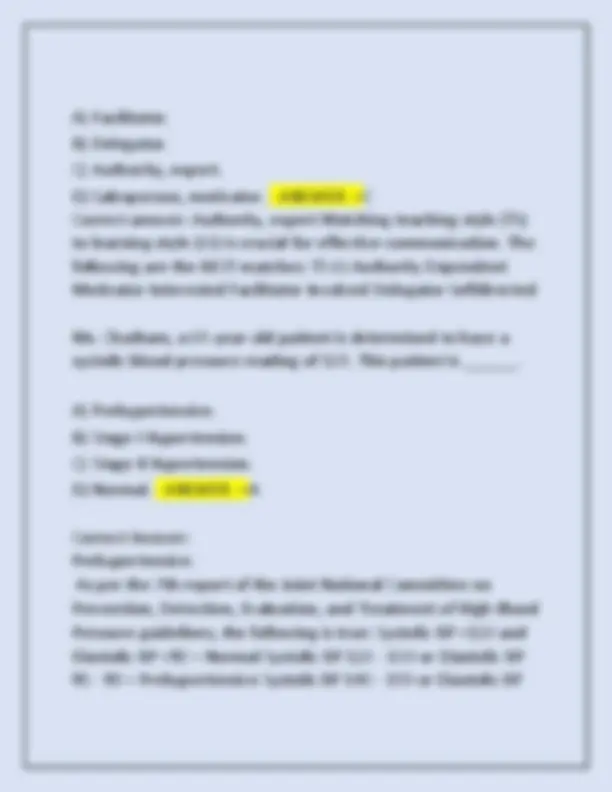
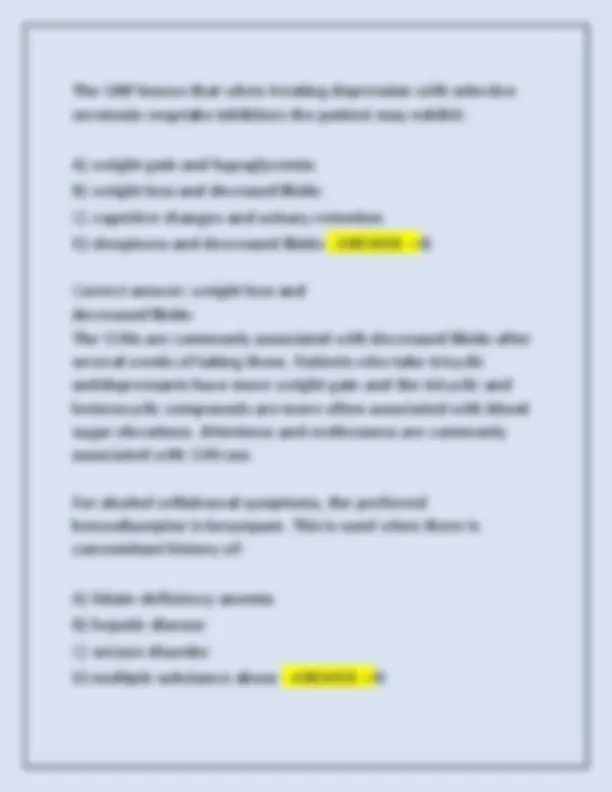
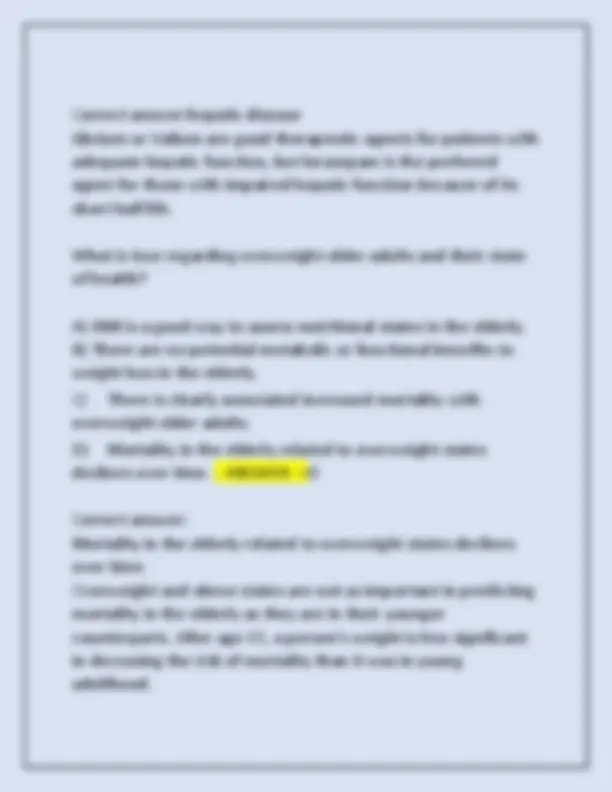
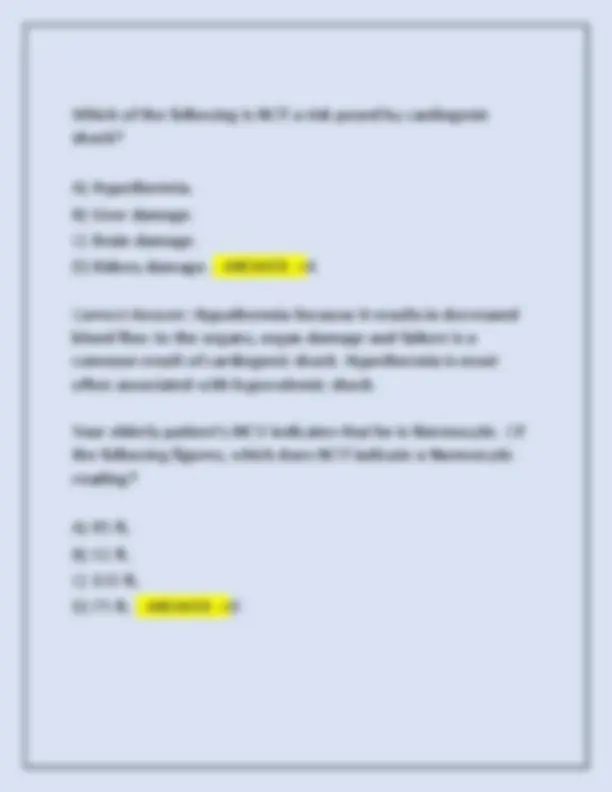
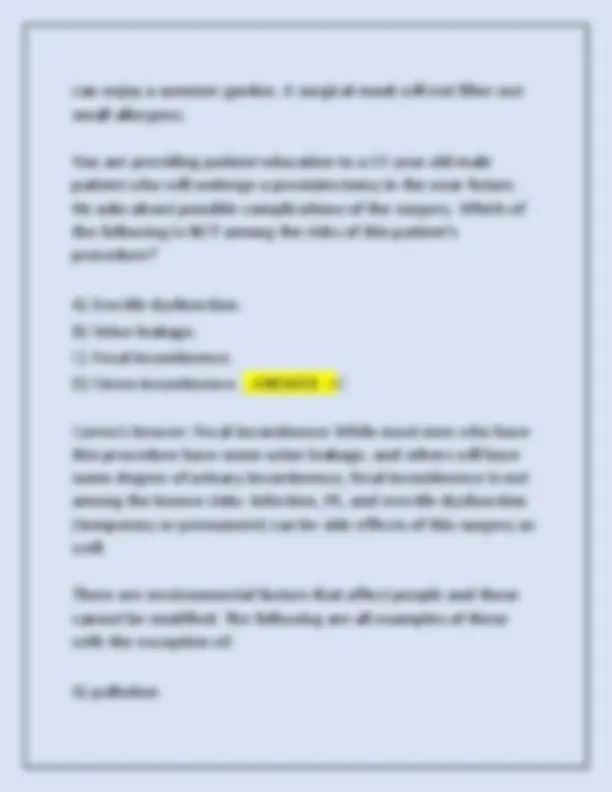
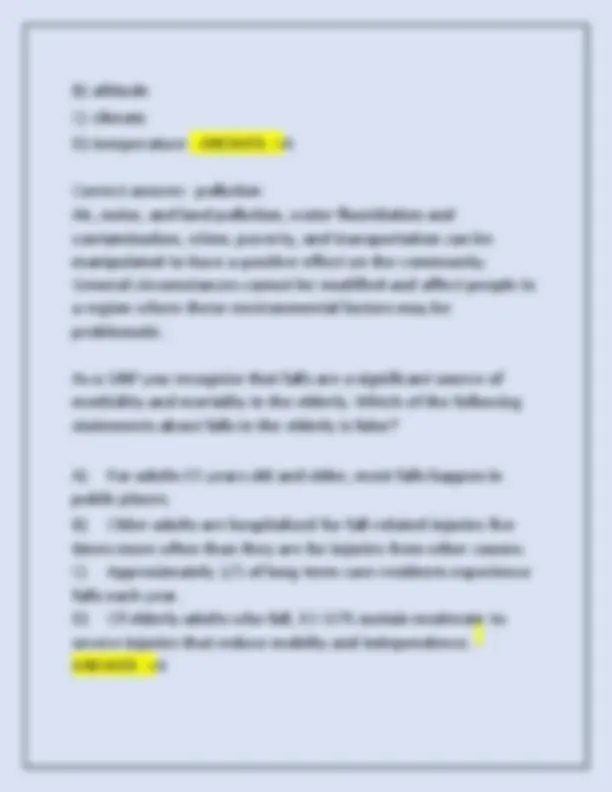
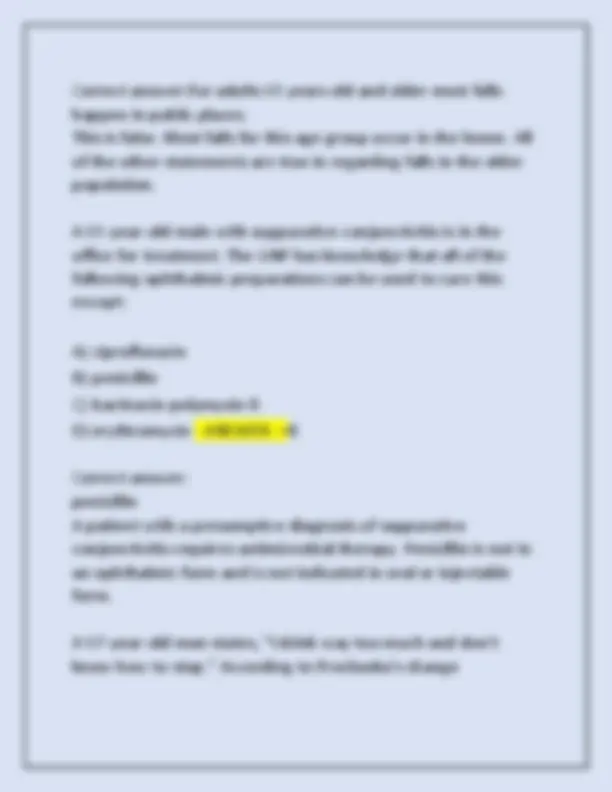
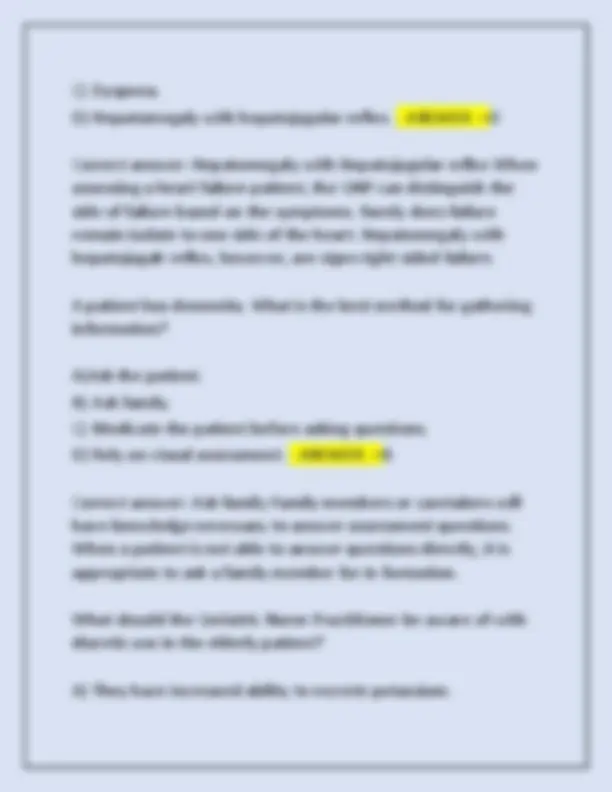
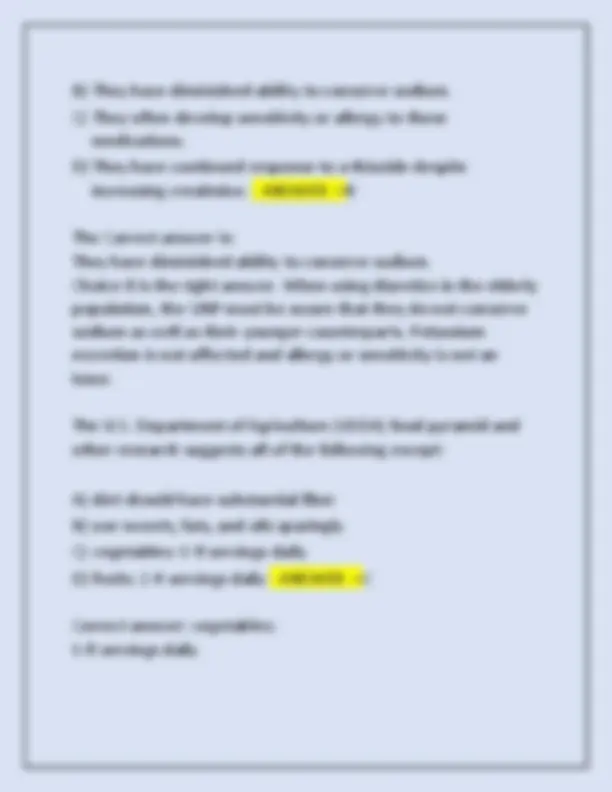
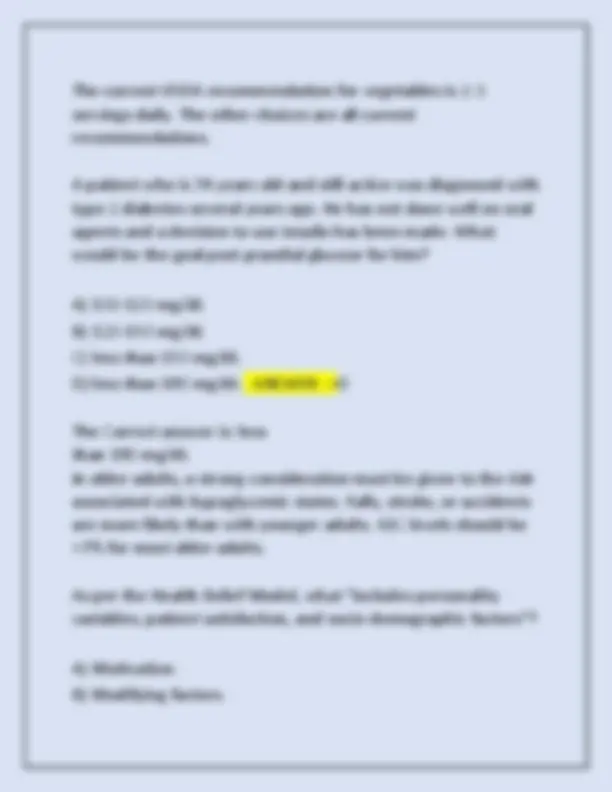
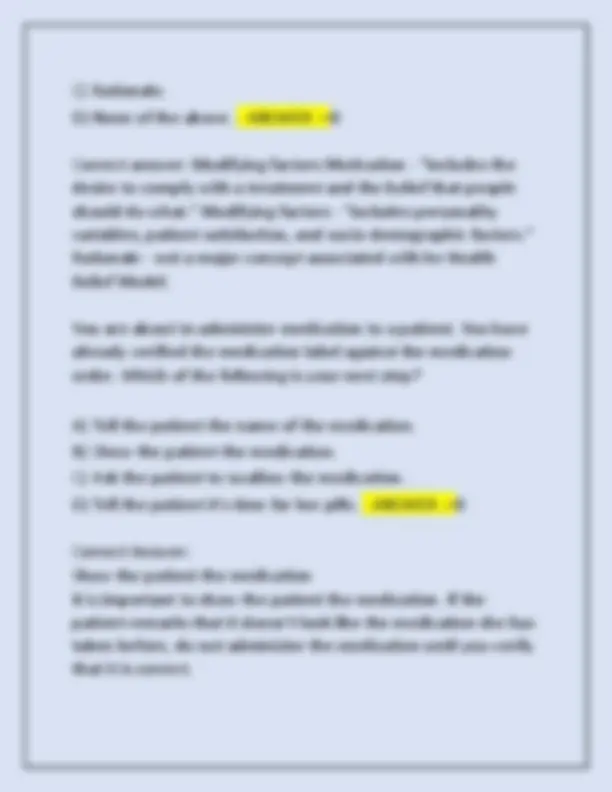
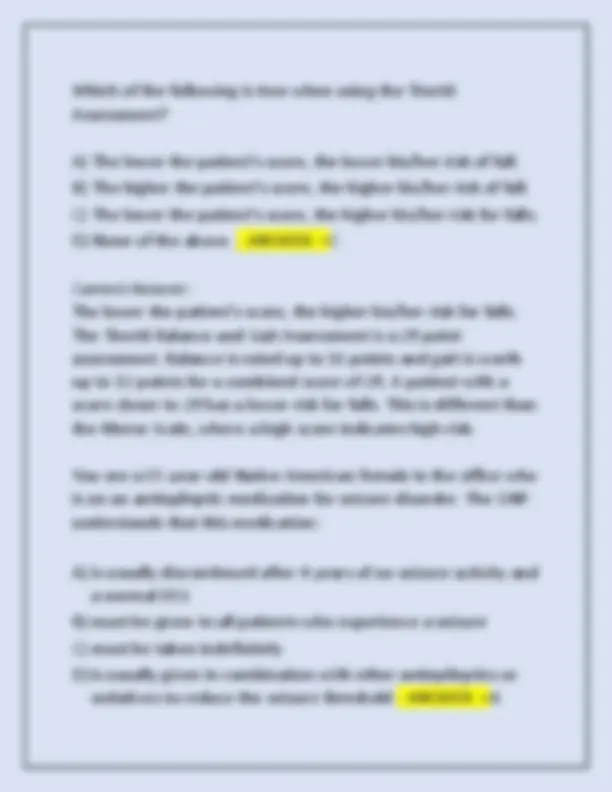
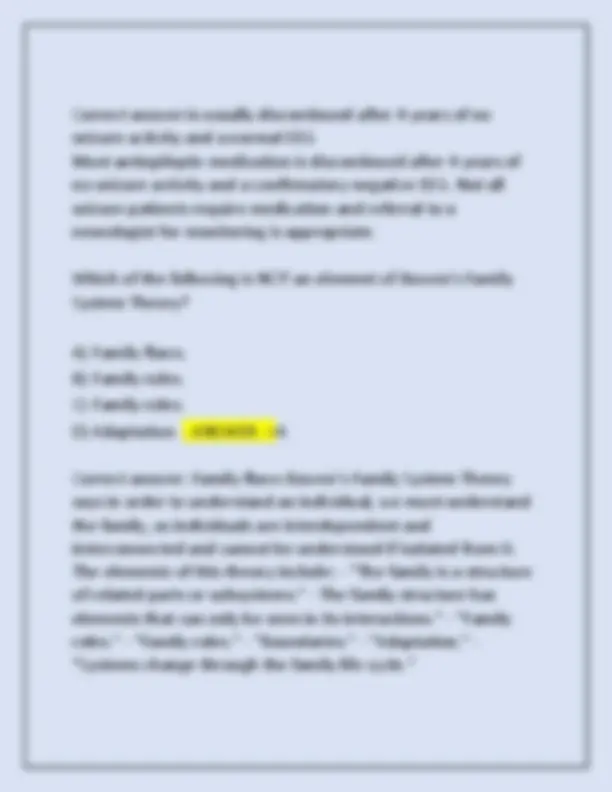
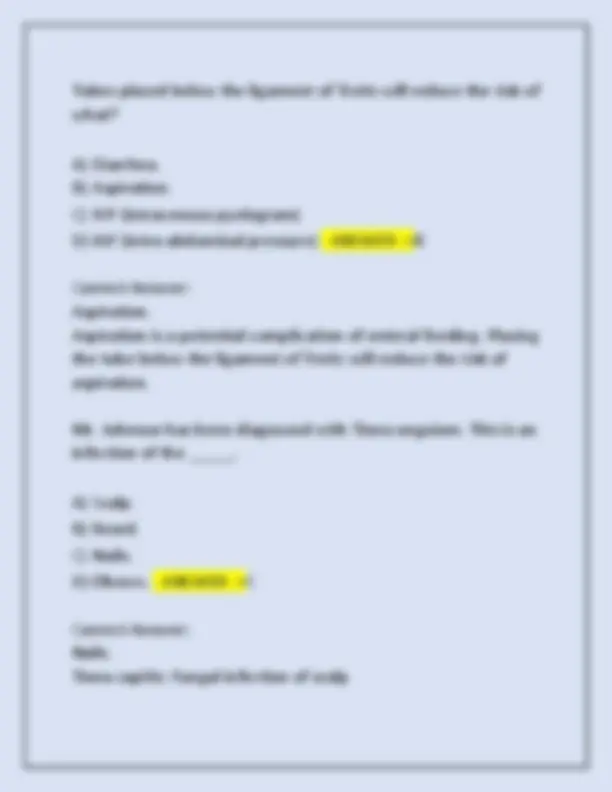
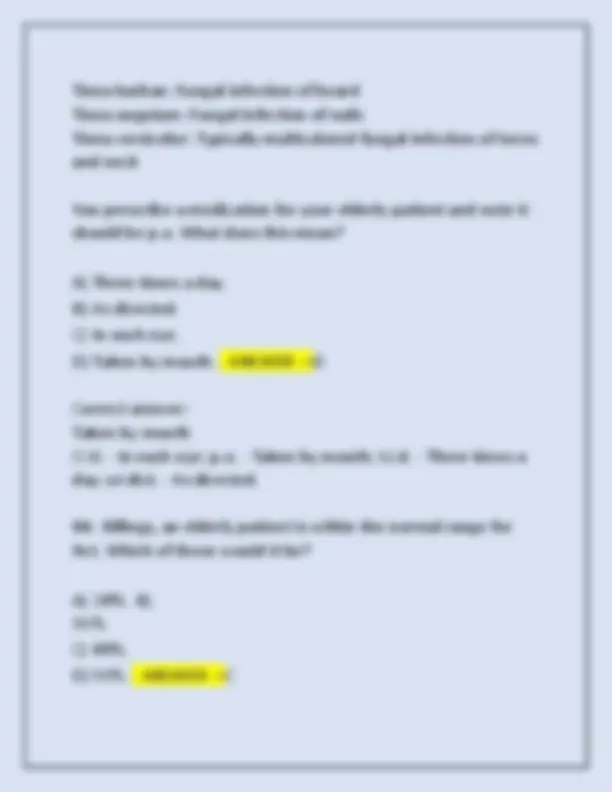
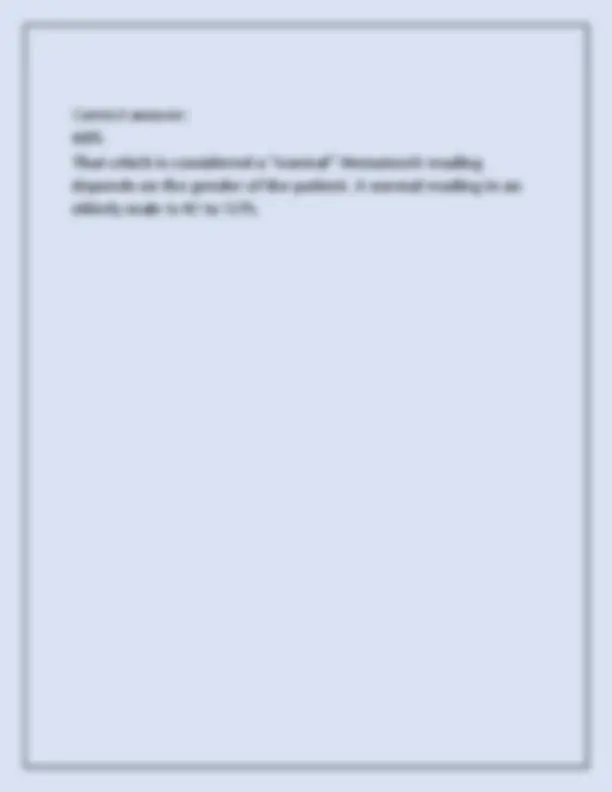
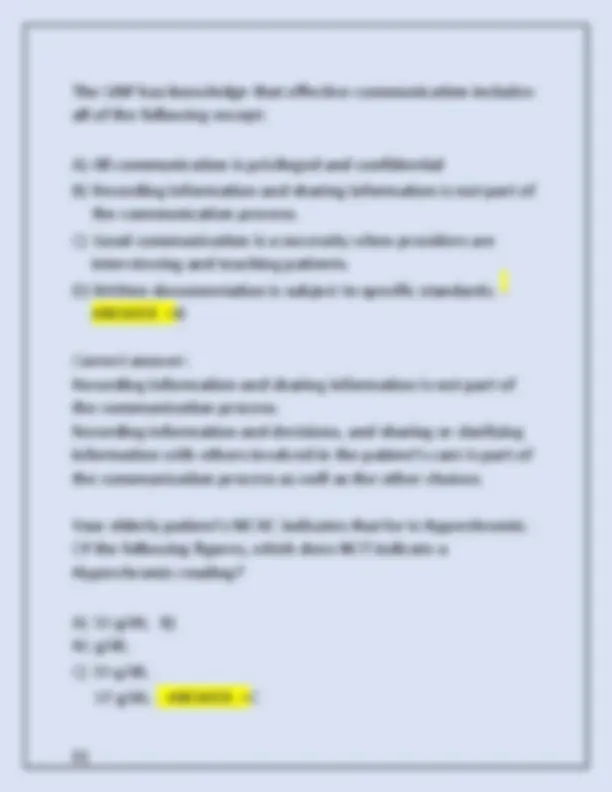
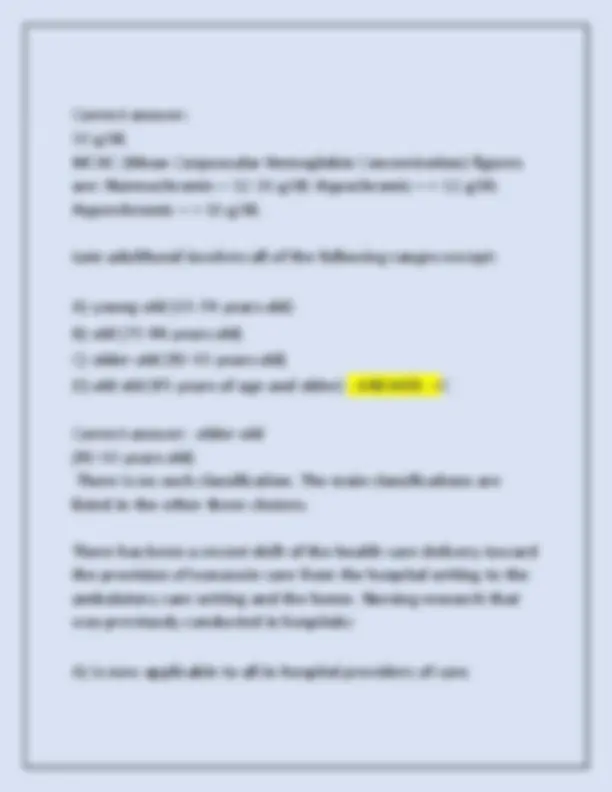
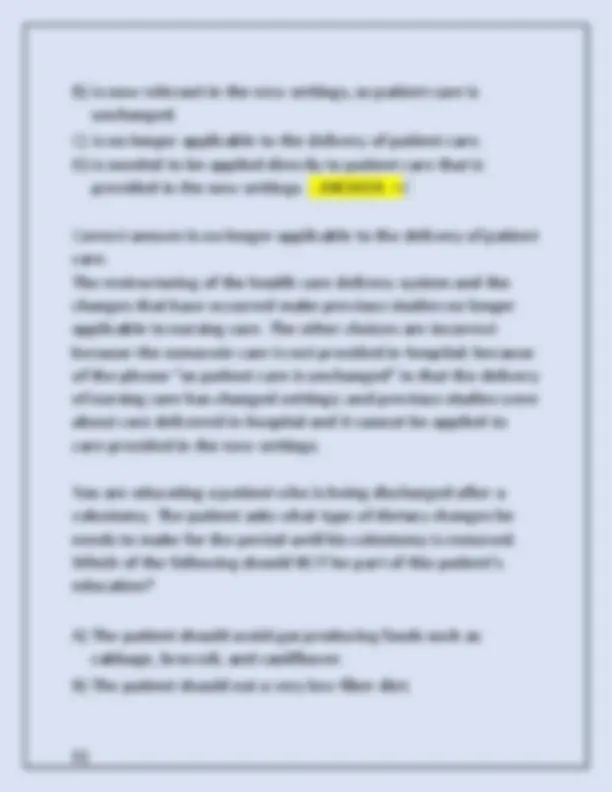
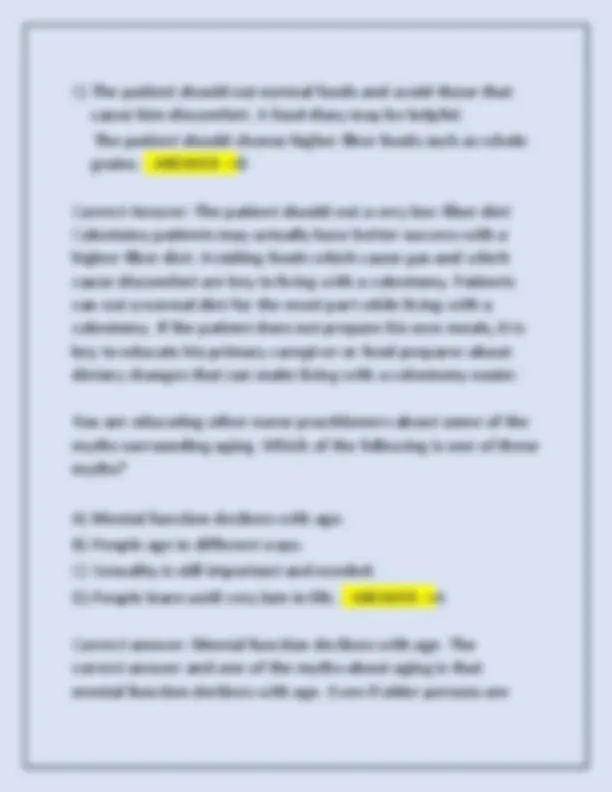
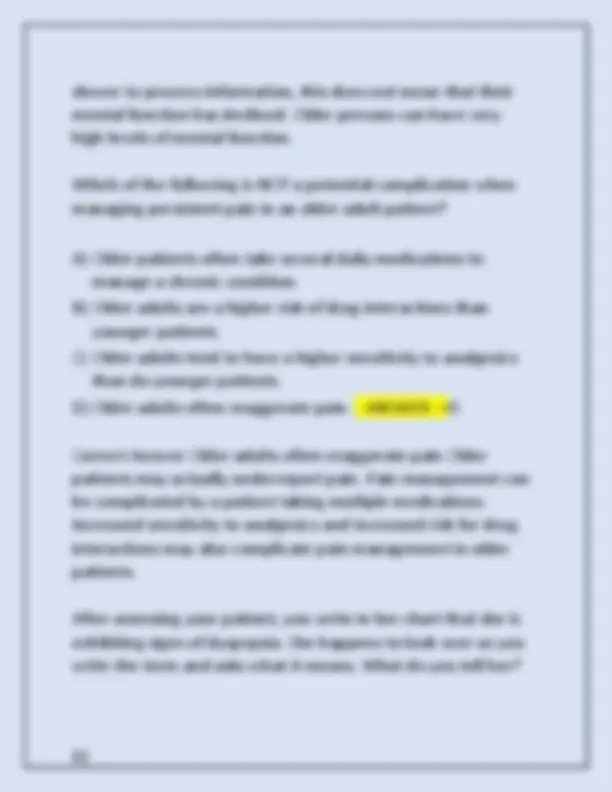
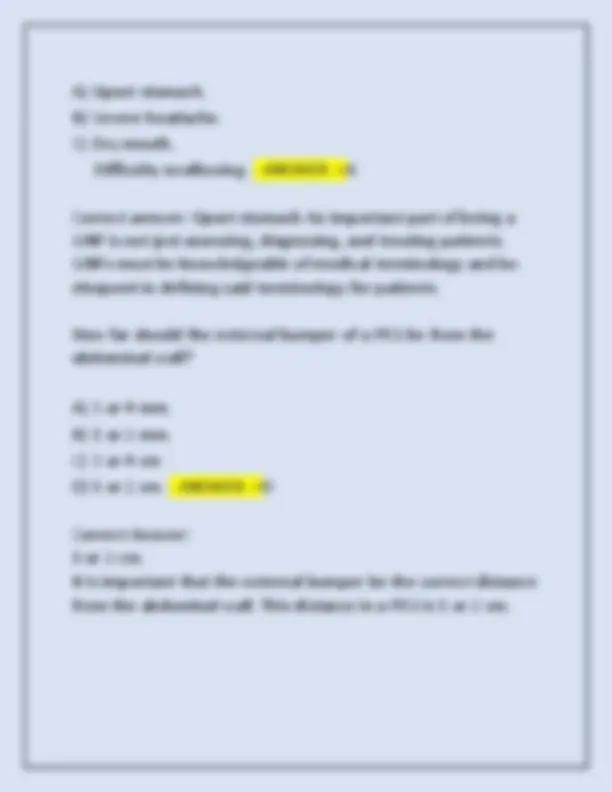
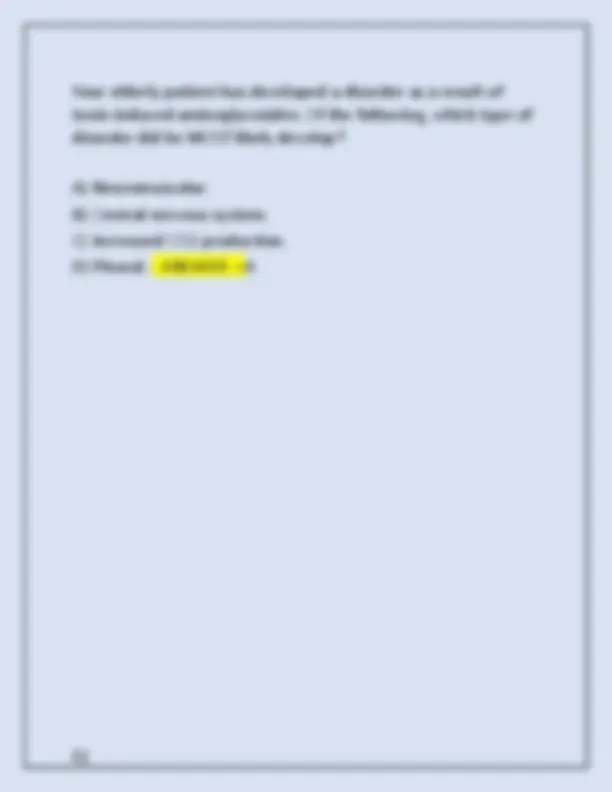
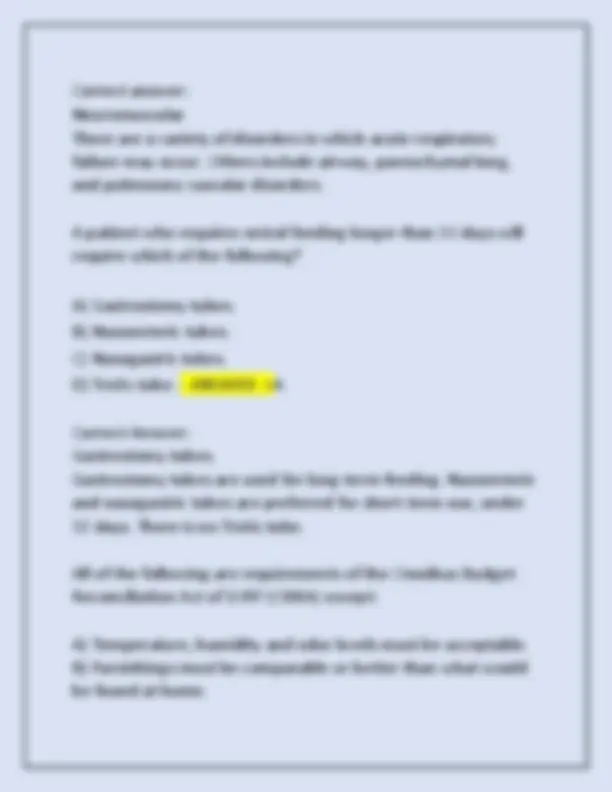
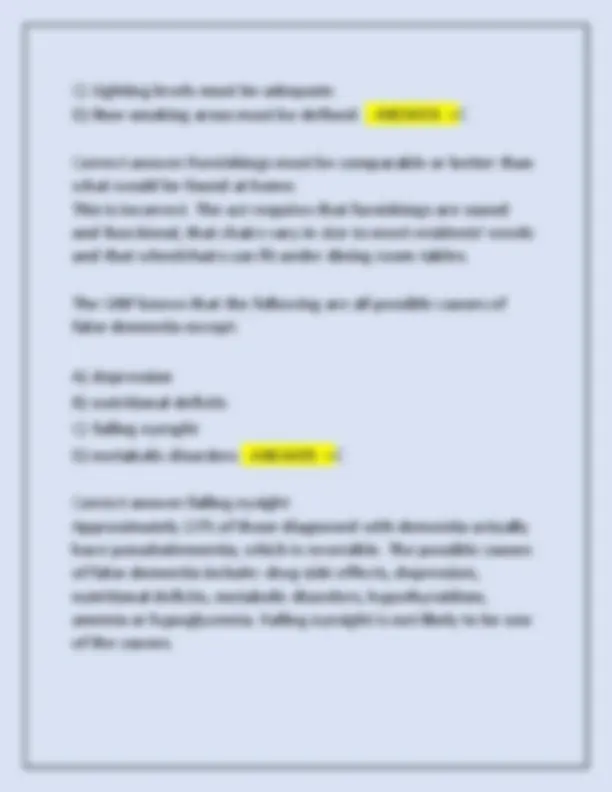
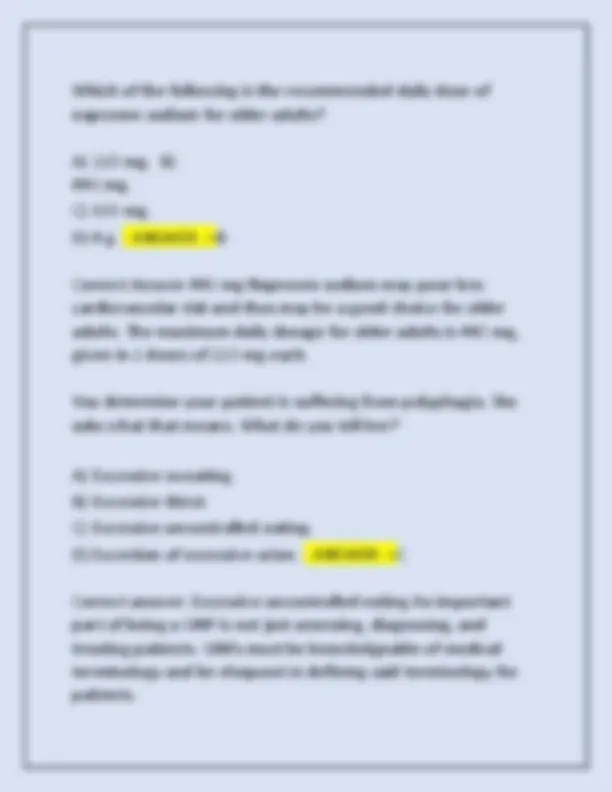
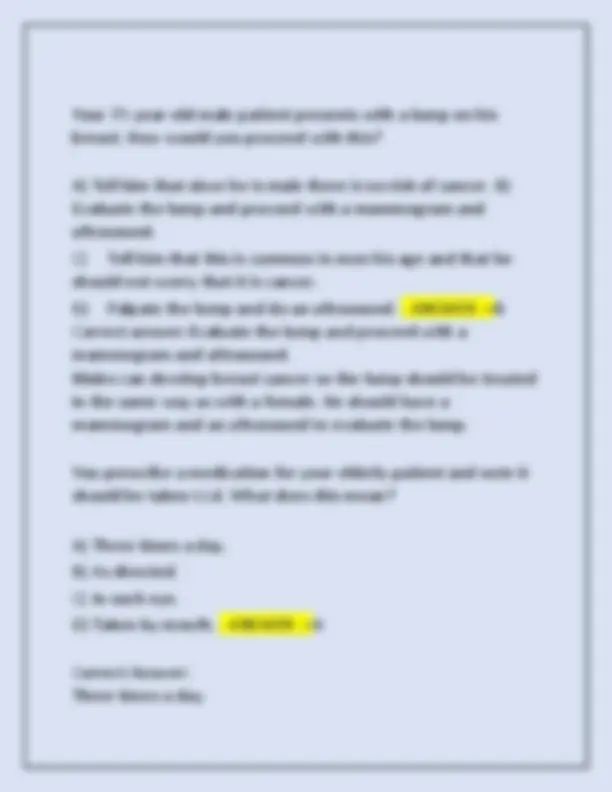
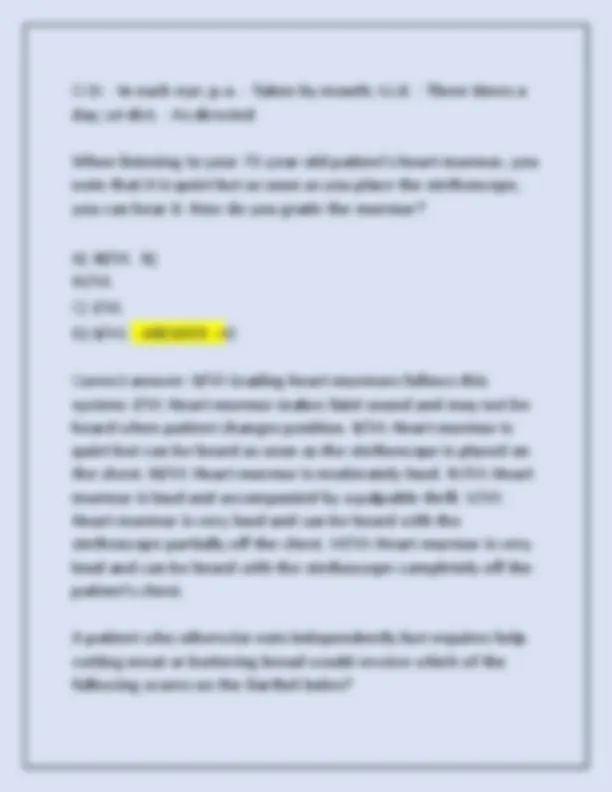
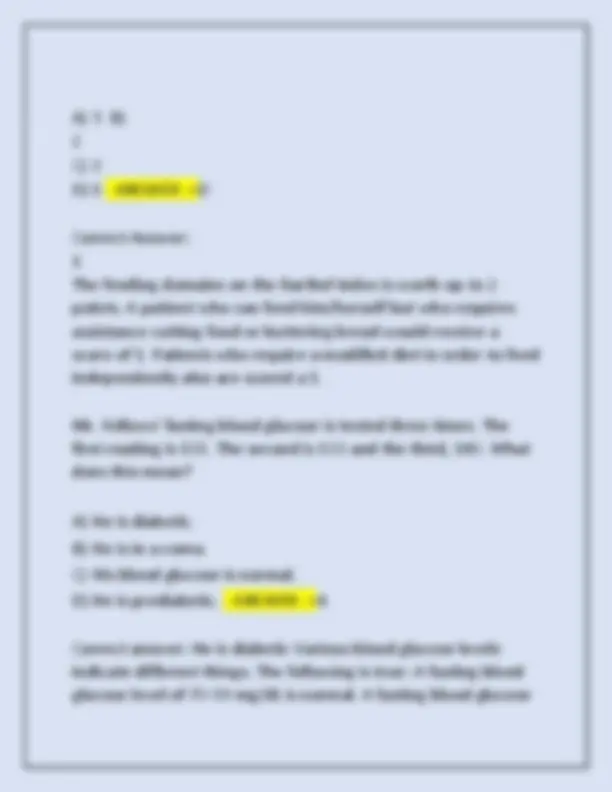
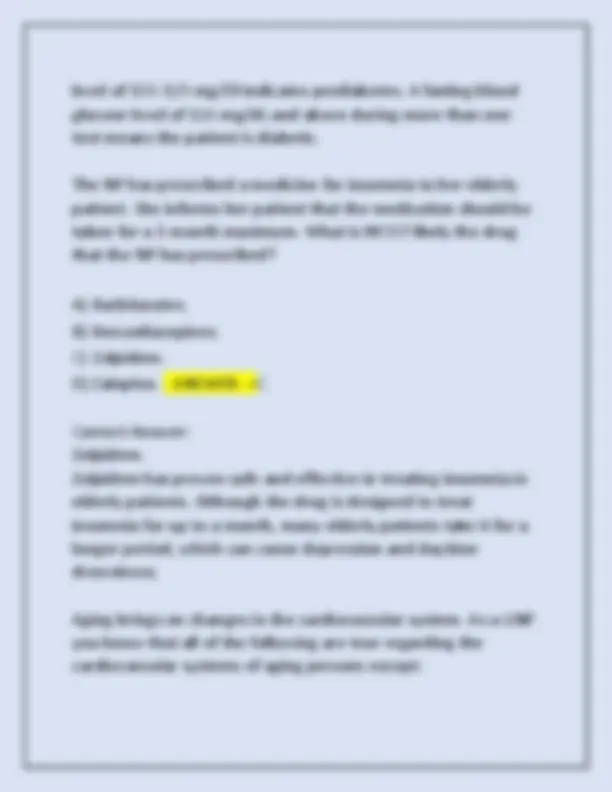
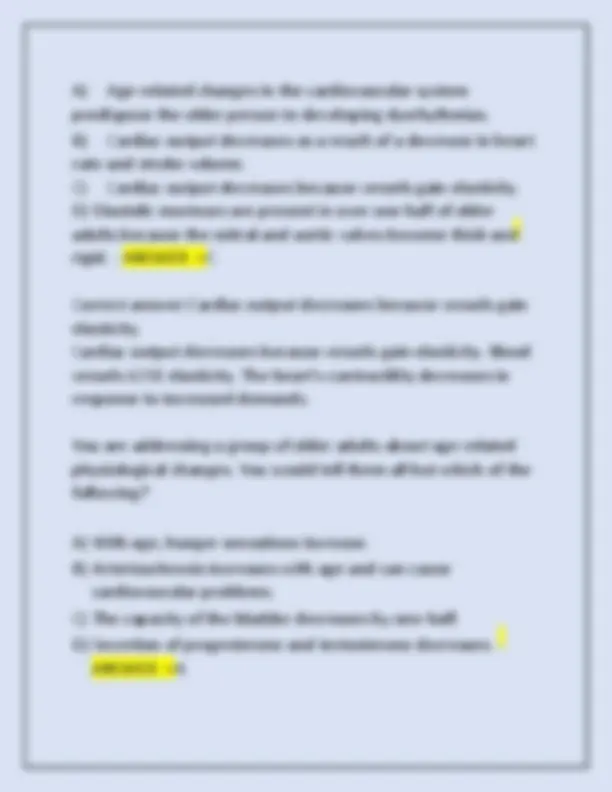
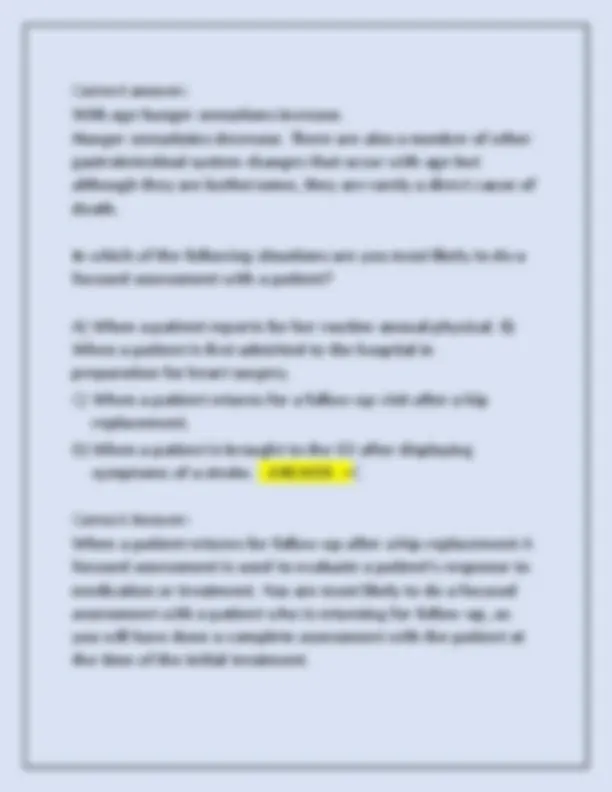
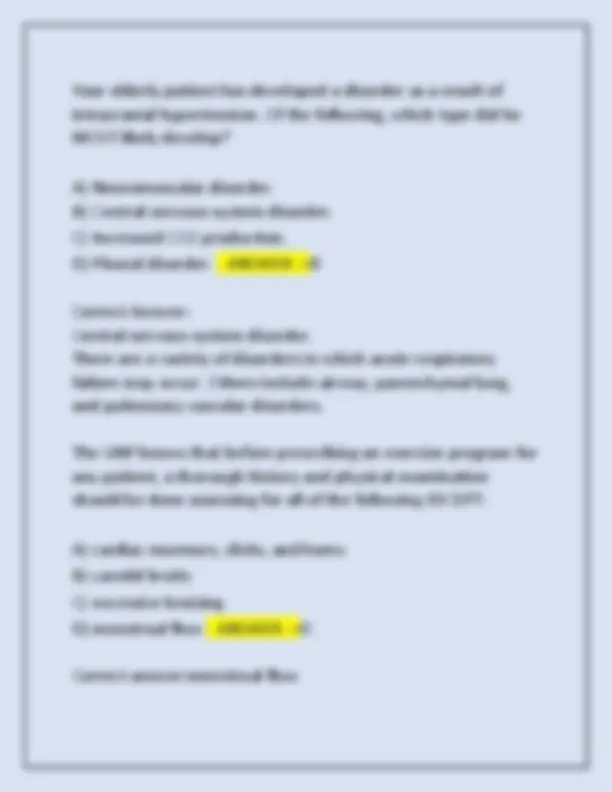
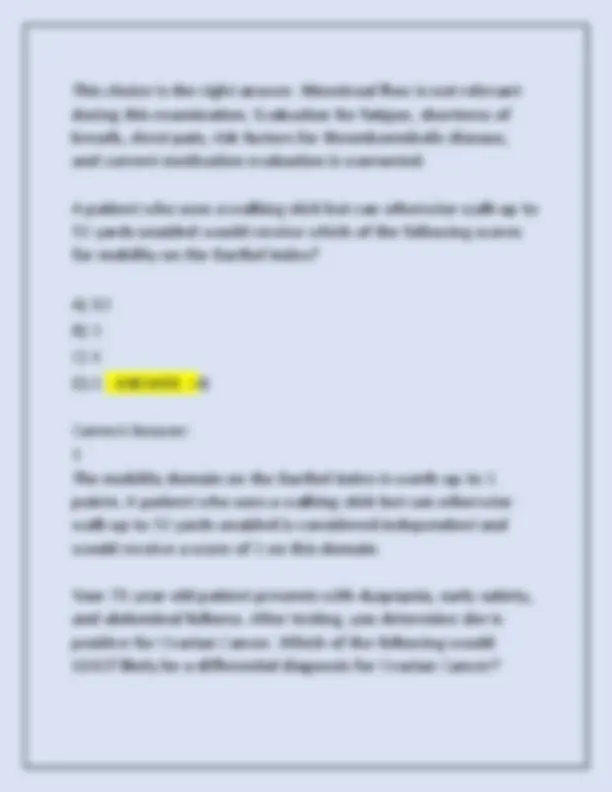
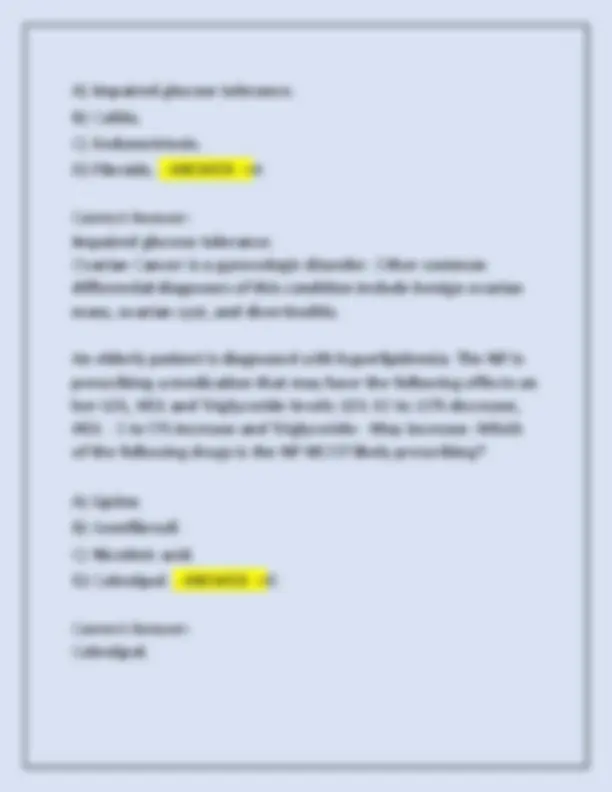
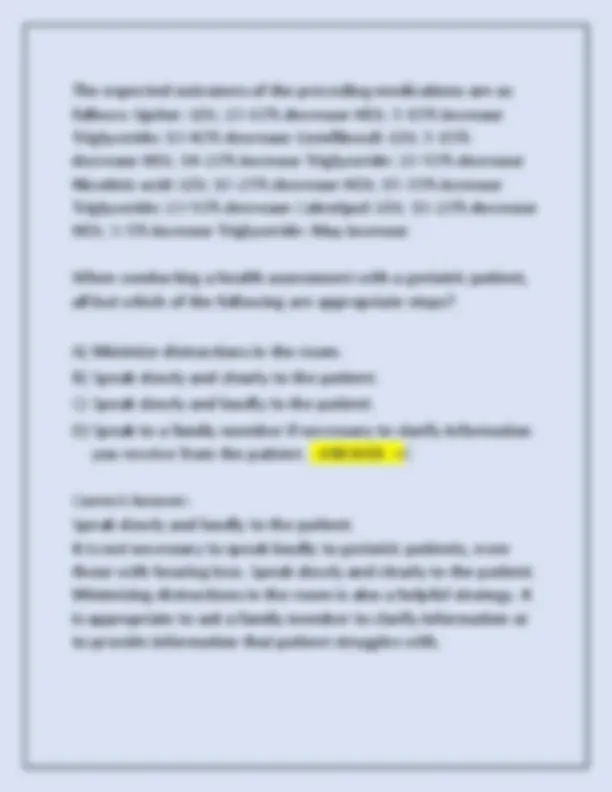
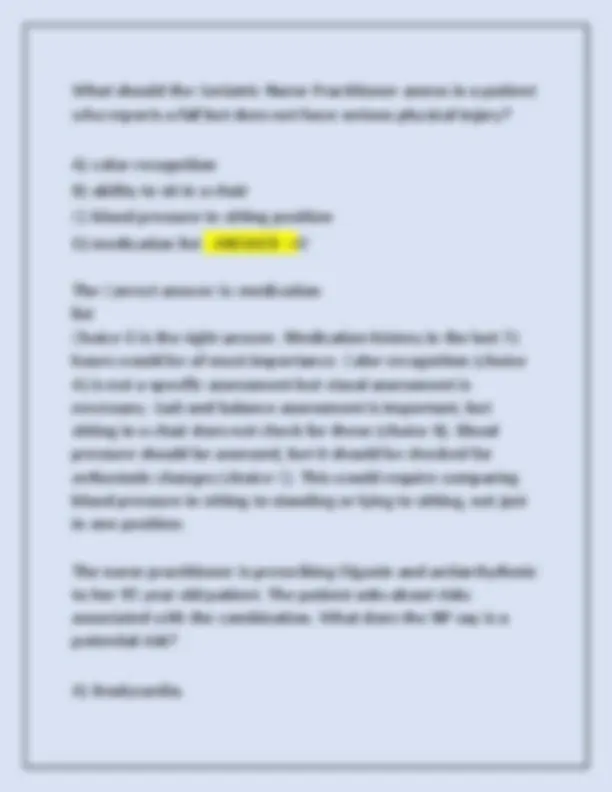
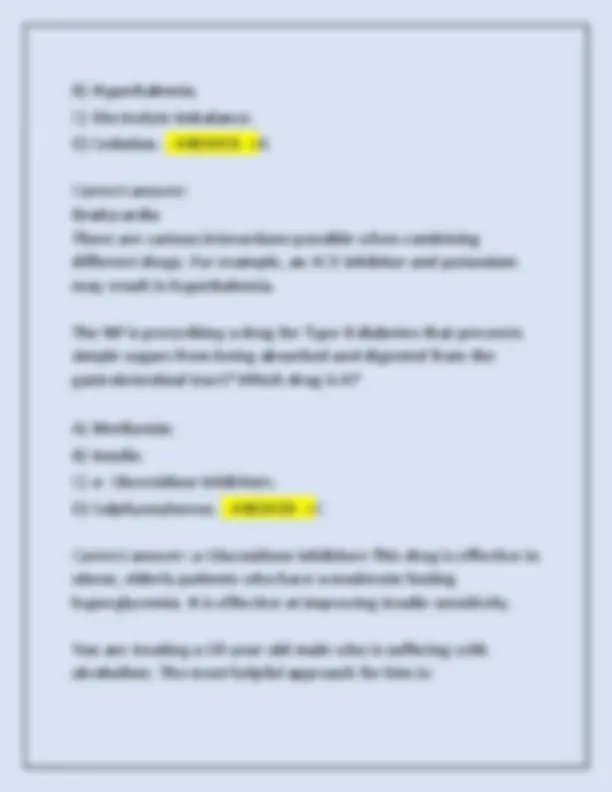
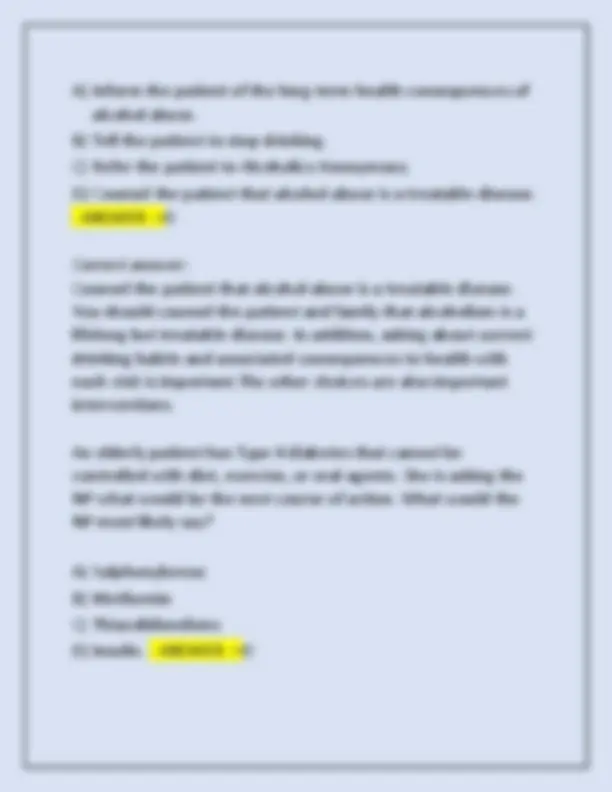
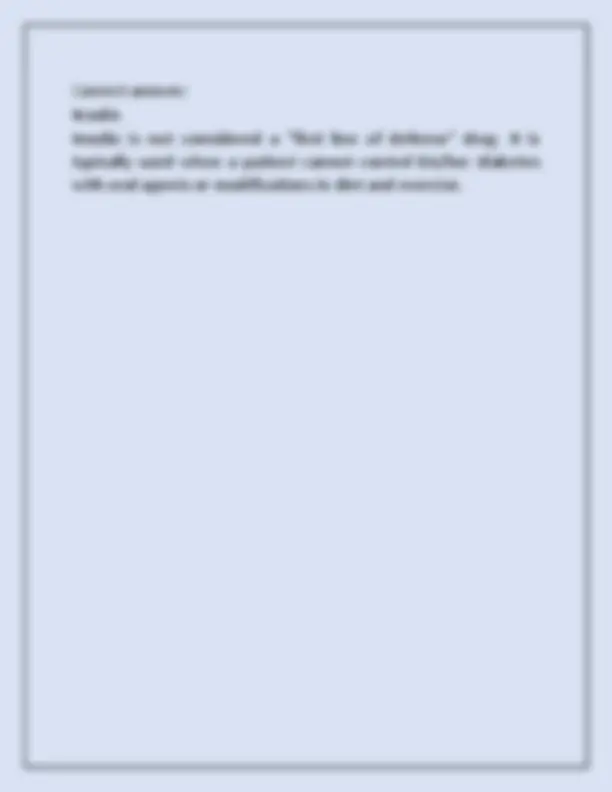


Study with the several resources on Docsity

Earn points by helping other students or get them with a premium plan


Prepare for your exams
Study with the several resources on Docsity

Earn points to download
Earn points by helping other students or get them with a premium plan
Community
Ask the community for help and clear up your study doubts
Discover the best universities in your country according to Docsity users
Free resources
Download our free guides on studying techniques, anxiety management strategies, and thesis advice from Docsity tutors
A series of multiple-choice questions and answers related to gerontology, covering topics such as gastric lavage, dietary considerations for dialysis patients, peptic ulcer disease, smoking cessation, dermatological conditions, cholesterol levels, teaching styles for different learners, hypertension, respiratory disabilities, tourette's syndrome, heart failure management, depression treatment, alcohol withdrawal, and nutritional states in older adults. It also addresses cardiogenic shock and diagnostic procedures for atrial fibrillation. This material is useful for students and professionals in healthcare.
Typology: Exams
1 / 50

This page cannot be seen from the preview
Don't miss anything!











































The cleansing of the stomach with solution delivered through a nasogastric tube is known as what? A) Gavage. B) Emesis. C) Lavage. D) Stomach pumping. - ANSWER - >C Correct Answer: Lavage Gastric lavage is used to cleanse the stomach of a poison, overdose of medication, or other toxic substance. It is delivered through a nasogastric tube. You are providing care to a patient who has recently begun dialysis. Her daughter, with whom she lives and who prepares many of her meals, asks what types of foods she should incorporate into her diet and which she should avoid. Which of the following is NOT a food that this patient should be advised to avoid? A) Avocado. B) Lean red meat.
C) Dried fruit. D) Bananas. - ANSWER - >B Correct Answer: Lean red meat Dialysis patients are encouraged to eat lean meat, including red meat. High quality proteins produce less waste and help the body heal and maintain regular processes. Dialysis patients should avoid foods high in potassium, including avocado, banana, and dried fruit, and should eat other potassium-containing foods in moderation. Your 89-year-old patient presents with dyspepsia and nausea. After testing, you determine she is positive for Peptic Ulcer Disease. Of the following, which would LEAST likely be a differential diagnosis for Peptic Ulcer Disease? A) Cholecystitis. B) Migraines. C) Gastric carcinoma. D) Cardiovascular disease. - ANSWER - >B Correct answer: Migraines Peptic Ulcer Disease is a gastrointestinal disorder. Other differential diagnoses of the condition are pancreatitis and biliary tract disease.
Cyst: encapsulated, fluid-filled mass that varies in size. Bulla: fluid-filled, elevated, circumscribed lesion that's larger than 5mm. Wheal: circumscribed, reddening with transient elevation lesion that's 0.5 to 10mm diameter. Plaques: usually a grouping of papules; elevated and a variety of shapes; larger than 5mm. Mr. French asks the GNP the maximum number he can have for his LDL Cholesterol level in order to be considered at a borderline high amount. What answer does she give him? A) 62 mg/dL. B) 159 mg/dL. C) 83 mg/dL. D) 95 mg/dL. - ANSWER - >B Correct Answer: 159 mg/dL. The following LDL cholesterol guidelines are outlined by the American Heart Association: Less than 100 mg/dL = Optimal 100 - 129 mg/dL = Near or above optimal 130-159 mg/dL = Borderline high 160-189 mg/dL = High 190 mg/dL and above = Very high In order for effective teaching to take place, it is crucial that the GNP use the proper teaching style for each patient. What teaching style would BEST suit a patient with a "Dependent Learner" style?
A) Facilitator. B) Delegator. C) Authority, expert. D) Salesperson, motivator. - ANSWER - >C Correct answer: Authority, expert Matching teaching style (TS) to learning style (LS) is crucial for effective communication. The following are the BEST matches: TS LS Authority Dependent Motivator Interested Facilitator Involved Delegator Selfdirected Ms. Chatham, a 65-year-old patient is determined to have a systolic blood pressure reading of 125. This patient is ______. A) Prehypertensive. B) Stage I Hypertension. C) Stage II Hypertension. D) Normal. - ANSWER - >A Correct Answer: Prehypertensive. As per the 7th report of the Joint National Committee on Prevention, Detection, Evaluation, and Treatment of High Blood Pressure guidelines, the following is true: Systolic BP <120 and Diastolic BP <80 = Normal Systolic BP 120 - 139 or Diastolic BP 80 - 89 = Prehypertensive Systolic BP 140 - 159 or Diastolic BP
Correct answer:high doses of diazepam have been known to be effective Treatment options include stimulants (dextroamphetamine, methylphenidate, etc.), alpha-2 adrenergic agonists (clonidine), and neuroleptic agents (risperidone, haloperidol, etc.). Tourette's syndrome is a lifelong condition with unknown etiology. You are prescribing Lisinopril for your 70-year-old patient with heart failure. What is the maximum daily dosage the patient can take of this medication? A) 4 mg/day. B) 20 mg once per day. C) 40 mg/day. D) 16 mg/day. - ANSWER - >C Correct Answer: 40 mg/day. There are a variety of drugs prescribed to patients to help manage heart failure. For example, the maximum daily dosage for Lisinopril is 40 mg once per day. The daily max. for Fosinopril is 40 mg/day. The daily maximum for Perindopril is 16 mg/day and Trandolapril, 4 mg/day.
The GNP knows that when treating depression with selective serotonin reuptake inhibitors the patient may exhibit: A) weight gain and hypoglycemia B) weight loss and decrased libido C) cognitive changes and urinary retention D) sleepiness and decreased libido - ANSWER - >B Correct answer: weight loss and decreased libido The SSRIs are commonly associated with decreased libido after several weeks of taking them. Patients who take tricyclic antidepressants have more weight gain and the tricyclic and heterocyclic compounds are more often associated with blood sugar elevations. Jitteriness and restlessness are commonly associated with SSRI use. For alcohol withdrawal symptoms, the preferred benzodiazepine is lorazepam. This is used when there is concomitant history of: A) folate-deficiency anemia B) hepatic disease C) seizure disorder D) multiple substance abuse - ANSWER - >B
Which of the following is NOT a risk posed by cardiogenic shock? A) Hypothermia. B) Liver damage. C) Brain damage. D) Kidney damage. - ANSWER - >A Correct Answer: Hypothermia Because it results in decreased blood flow to the organs, organ damage and failure is a common result of cardiogenic shock. Hypothermia is most often associated with hypovolemic shock. Your elderly patient's MCV indicates that he is Normocytic. Of the following figures, which does NOT indicate a Normocytic reading? A) 85 fL. B) 92 fL. C) 100 fL. D) 75 fL. - ANSWER - >D
Correct answer: 75 fL MCV (Mean corpuscular volume) figures are: Normocytic = 80-100 fL Microcytic = < 80 fL Macrocytic = > 100 fL A 65 year female patient with chest pain is being diagnosed to determine the etiology of her atrial fibrillation. An echocardiogram was recently performed to check the function of the left ventricle, valvular function, atrial size and for the presence of cardiac thrombi. The transthoracic echo is negative, the GNP should then consider: A) Chest x-ray. B) 12 - lead electrocardiogram. C) Ventilation-perfusion scan. D) Transesophageal echo. - ANSWER - >D Correct answer: Transesophageal echo A patient who has atrial fibrillation will first have a 12-lead electrocardiogram. Then, the provider should proceed diagnosis with an echocardiogram to assess left ventricular function, valvular function, atrial size and for the presence of thrombi. If the transthoracic echo is negative, then a transesophageal eco should be performed. Aging involves the concept of loss. Which of the following losses is not one of the psychosocial losses associated with aging?
can enjoy a summer garden. A surgical mask will not filter out small allergens. You are providing patient education to a 65 year old male patient who will undergo a prostatectomy in the near future. He asks about possible complications of the surgery. Which of the following is NOT among the risks of this patient's procedure? A) Erectile dysfunction. B) Urine leakage. C) Fecal incontinence. D) Stress incontinence. - ANSWER - >C Correct Answer: Fecal incontinence While most men who have this procedure have some urine leakage, and others will have some degree of urinary incontinence, fecal incontinence is not among the known risks. Infection, PE, and erectile dysfunction (temporary or permanent) can be side effects of this surgery as well. There are environmental factors that affect people and these cannot be modified. The following are all examples of these with the exception of: A) pollution
B) altitude C) climate D) temperature - ANSWER - >A Correct answer: pollution Air, noise, and land pollution, water fluoridation and contamination, crime, poverty, and transportation can be manipulated to have a positive effect on the community. General circumstances cannot be modified and affect people in a region where these environmental factors may be problematic. As a GNP you recognize that falls are a significant source of morbidity and mortality in the elderly. Which of the following statements about falls in the elderly is false? A) For adults 65 years old and older, most falls happen in public places. B) Older adults are hospitalized for fall-related injuries five times more often than they are for injuries from other causes. C) Approximately 2/3 of long-term care residents experience falls each year. D) Of elderly adults who fall, 10-30% sustain moderate to severe injuries that reduce mobilty and independence. - ANSWER - >A
framework, the statement is most consistent with a person at the stage of: A) action B) preparation C) precontemplation D) contemplation - ANSWER - >D Correct answer: contemplation During the stage of contemplation, the patient is considering change and looking at its positive and negative aspects. The person often reports feeling "stuck" with the problem. During precontemplation, the patient is not interested in change. Action and preparation are after contemplation, when change begins to occur. Which of the following is NOT a sign of depression in an older adult? A) His speech is impaired. B) His speech is slow but clear. C) He reports difficulty sleeping. D) He expresses concern over being a burden to his children. - ANSWER - >A
Correct Answer His speech is impaired Depression may cause older adults to speak or move more slowly. It does not cause impairment, however. Impaired speech is more often a sign of dementia than depression. Depression may cause difficulty sleeping as well. Depressed elders may express worry over becoming a burden to children or others. Oral lesions are often asymptomatic and commonly found during routine examination, especially in patients with dentures. An additional risk for oral candidiasis includes: A) Beta blockers. B) Non-steroidal anti-inflammatory drugs (NSAID). C) Insulin. D) Topical steroids. - ANSWER - >C Correct answer: Insulin Oral candidiasis results in lesions in the mouth. Patients at risk for oral candidiasis include those who use inhaled or oral steroids, recent antibiotics, and insulin. When assessing a patient with heart failure, the nurse can determine side of the failure based on the signs or symptoms. A sign of right-sided heart failure includes: A) Cough with blood-tinged sputum. B) Pulsus alternans.
B) They have diminished ability to conserve sodium. C) They often develop sensitivity or allergy to these medications. D) They have continued response to a thiazide despite increasing creatinine. - ANSWER - >B The Correct answer is: They have diminished ability to conserve sodium. Choice B is the right answer. When using diuretics in the elderly population, the GNP must be aware that they do not conserve sodium as well as their younger counterparts. Potassium excretion is not affected and allergy or sensitivity is not an issue. The U.S. Department of Agriculture (USDA) food pyramid and other research suggests all of the following except: A) diet should have substantial fiber B) use sweets, fats, and oils sparingly C) vegetables: 6-8 servings daily D) fruits: 2-4 servings daily - ANSWER - >C Correct answer: vegetables: 6 - 8 servings daily
The current USDA recommendation for vegetables is 2- 3 servings daily. The other choices are all current recommendations. A patient who is 74 years old and still active was diagnosed with type 2 diabetes several years ago. He has not done well on oral agents and a decision to use insulin has been made. What would be the goal post prandial glucose for him? A) 100 - 120 mg/dL B) 120 - 150 mg/dL C) less than 150 mg/dL D) less than 180 mg/dL - ANSWER - >D The Correct answer is: less than 180 mg/dL In older adults, a strong consideration must be given to the risk associated with hypoglycemic states. Falls, stroke, or accidents are more likely than with younger adults. A1C levels should be <7% for most older adults. As per the Health Belief Model, what "includes personality variables, patient satisfaction, and socio-demographic factors"? A) Motivation. B) Modifying factors.